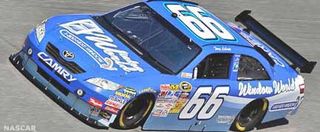NASCAR Technology Makes Passenger Cars Safer

Imagine it's 30 minutes before the green flag drops on Sunday's 51st Daytona 500 stock car race.
Realizing you don't have nearly enough Buffalo wings, you try to set your own track record on the way to the supermarket. If only your car had some of that cutting edge NASCAR technology, then you could make the trip in half the time and not worry about hitting a few mailboxes on the way.
Actually, today's production passenger cars have borrowed several innovations from both stock car and Indy-style racing. Here are five of the most useful technologies that have sped to the production line. 1. Keyless Ignition When was the last time you saw Jeff Gordon patting down his pockets wondering what he did with his car keys? Thanks to keyless ignition, he can crawl in behind the wheel, hit the switch and go. Several luxury passenger cars are now offering a similar push-button feature. Of course, passenger cars need to be a little more concerned with security, so either keys, fobs or biometric systems are used to get inside the car. 2. Semi-Automatic Transmissions When watching a Formula 1 race on TV, you may have noticed how the driver shifts gears with the flick of a lever located right behind the steering wheel. A mix between automatic and manual transmission, these direct shift gearboxes allow sequential shifting without depressing a clutch pedal or moving a shift lever through the traditional "H" pattern.
With a flick away from the driver, the transmission moves up gear by gear, with downshifting controlled by flicks towards the driver.
Now, this semi-automatic technology is available on high-end production cars. Drivers can choose to take control of the shifting or let the computer do the work. The 8 milliseconds it takes to go from one gear to another eliminates the "shift jolt" that pure manual transmissions cause when the clutch disengages, then engages the engine. This smoother transition can also increase gas mileage by up to 10 percent. 3. Door cushioning In a race car, seat belts and head/neck restraints protect the drivers against front and rear collisions, but a "T-bone" or side collision can be even more dangerous as there is a much smaller "crumple" zone.
NASCAR's Car of Tomorrow (CoT), which was tested in recent years in an effort to reduce deaths and serious injuries, is now the car of today. Among its innovations, cushioning foam is inserted into the doors to absorb as much impact as possible. NASCAR chose a polystyrene foam material called Impaxx from Dow Automotive. Its millions of tiny air bubbles each absorb some of the impact, lessening the energy transferred to the driver.
Impaxx is now used in more than 2 million passenger automobiles. 4. Lightweight Body Materials To be fast, race cars need to be powerful while weighing as little as possible. Yet, the stresses of high-speed driving demand strong materials. As substitutes for sheet metal, carbon fiber and aluminum now make up most of the body of a Formula 1 race car and have been introduced in strategic places on the CoT. For production car models there are fuel-saving opportunities as total car weights can be reduced. 5. Soft Walls Finally, the technology with the greatest potential to keep us safe is not even a part of the car.
Sign up for the Live Science daily newsletter now
Get the world’s most fascinating discoveries delivered straight to your inbox.
It took the death of the sport's icon, Dale Earnhardt, on the final lap of the 2001 Daytona 500 to jump-start the development of a more energy absorbing wall that surrounds the racetrack. Earnhardt crashed head-on into a concrete wall at 180 mph.
The Steel and Foam Energy Reduction (SAFER) barrier — developed at the University of Nebraska, with funding and support by the Indy Racing League — dissipates the energy of a crash away from the car and driver. It is a system of structural steel tubes backed by Owens Corning Formular 150 foam with similar properties as Impaxx foam. This system is placed in front of the existing concrete walls. Since the first SAFER wall was installed in 2002, there has not been a serious injury to a driver, despite many soft wall crashes.
Several state highway departments are now evaluating the technology for use along dangerous stretches of freeway.
- The Daytona 500: Flying Without Leaving the Ground
- NASCAR Engineers Help Design New Combat Vehicle
- 200-mph Ads: The Top 5 NASCAR Paint Jobs
Dan Peterson writes about sports science at his site Sports Are 80 Percent Mental. His column is published Thursdays on LiveScience.
Most Popular


